401213 Clinical Leadership: Reflection on Laissez-Faire Style
VerifiedAdded on 2023/06/03
|7
|1169
|468
Essay
AI Summary
This essay delves into the laissez-faire leadership style within a clinical setting, contrasting it with other approaches like transformational and transactional leadership. It defines laissez-faire as a leadership approach where leaders grant decision-making autonomy to team members, potentially boosting motivation and productivity among highly skilled nurses. The essay highlights the advantages of this style for experienced professionals who thrive on independence, while also acknowledging its potential drawbacks for less skilled or inexperienced team members who require more guidance. The author expresses a preference for laissez-faire leadership, emphasizing its attributes such as minimal leader influence and guidance, and reflects on its application within a group setting. The conclusion underscores that while actively involved leadership fosters team cohesion, laissez-faire can lead to reduced cohesion and productivity if not appropriately applied. The essay references several academic sources to support its analysis of leadership styles and their impact on healthcare settings.
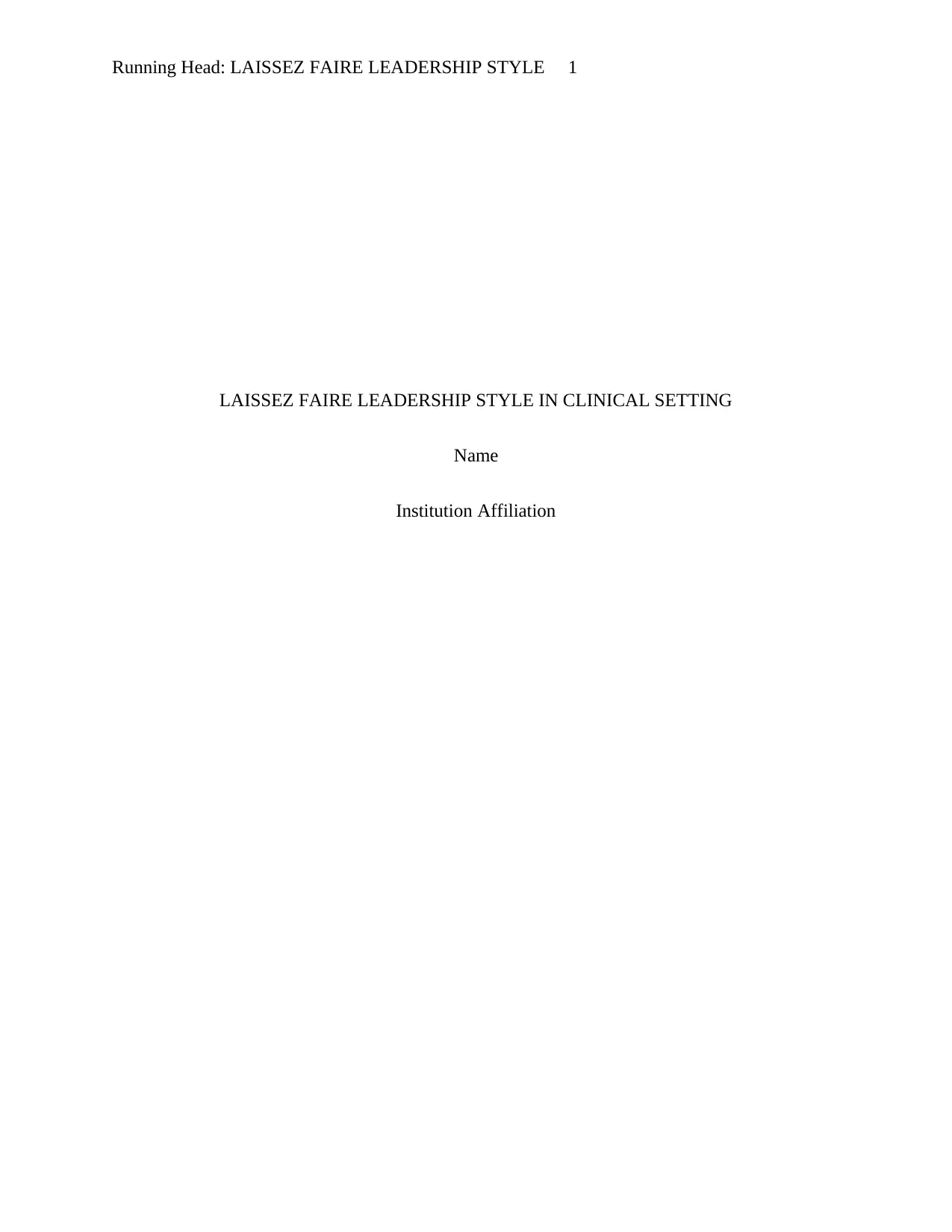
Running Head: LAISSEZ FAIRE LEADERSHIP STYLE 1
LAISSEZ FAIRE LEADERSHIP STYLE IN CLINICAL SETTING
Name
Institution Affiliation
LAISSEZ FAIRE LEADERSHIP STYLE IN CLINICAL SETTING
Name
Institution Affiliation
Paraphrase This Document
Need a fresh take? Get an instant paraphrase of this document with our AI Paraphraser
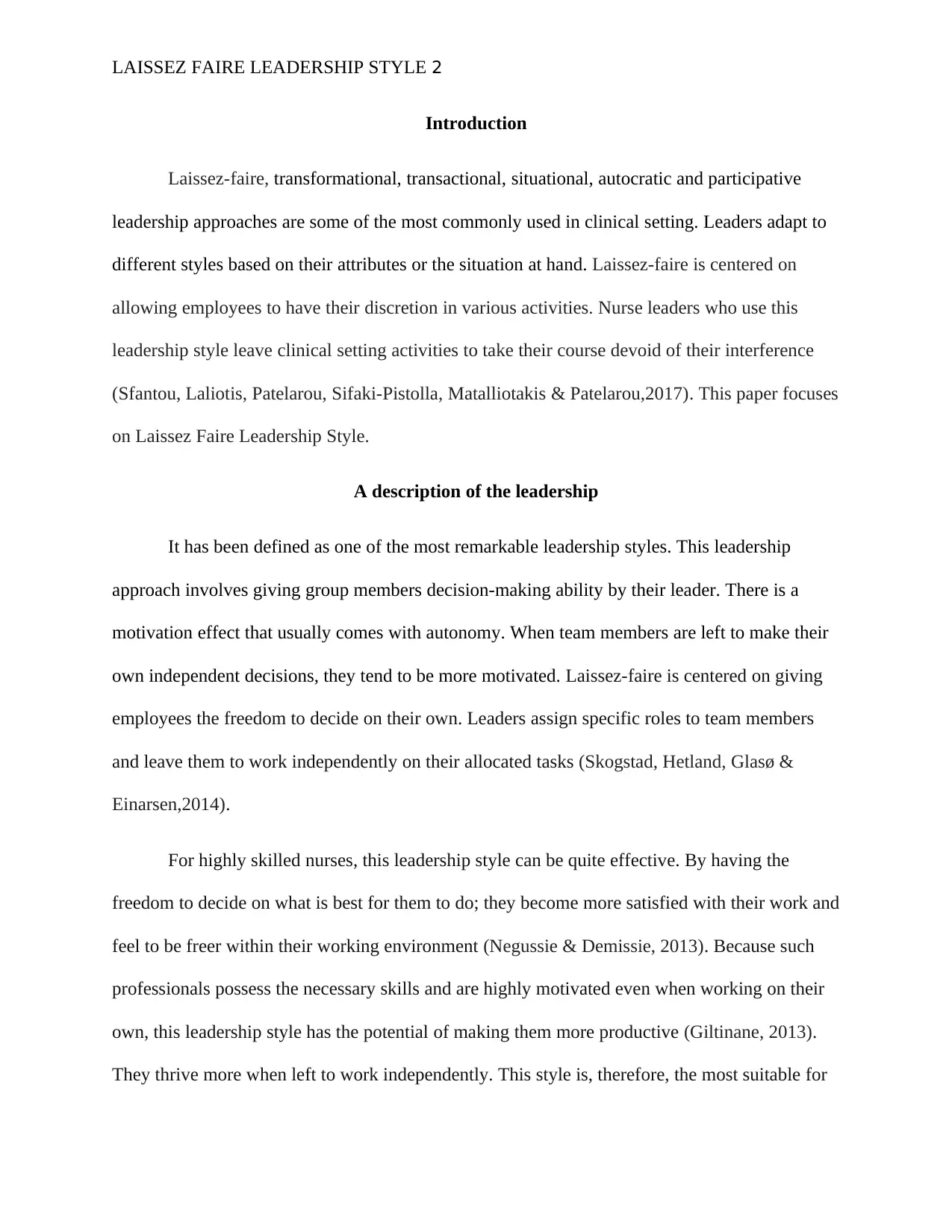
LAISSEZ FAIRE LEADERSHIP STYLE 2
Introduction
Laissez-faire, transformational, transactional, situational, autocratic and participative
leadership approaches are some of the most commonly used in clinical setting. Leaders adapt to
different styles based on their attributes or the situation at hand. Laissez-faire is centered on
allowing employees to have their discretion in various activities. Nurse leaders who use this
leadership style leave clinical setting activities to take their course devoid of their interference
(Sfantou, Laliotis, Patelarou, Sifaki-Pistolla, Matalliotakis & Patelarou,2017). This paper focuses
on Laissez Faire Leadership Style.
A description of the leadership
It has been defined as one of the most remarkable leadership styles. This leadership
approach involves giving group members decision-making ability by their leader. There is a
motivation effect that usually comes with autonomy. When team members are left to make their
own independent decisions, they tend to be more motivated. Laissez-faire is centered on giving
employees the freedom to decide on their own. Leaders assign specific roles to team members
and leave them to work independently on their allocated tasks (Skogstad, Hetland, Glasø &
Einarsen,2014).
For highly skilled nurses, this leadership style can be quite effective. By having the
freedom to decide on what is best for them to do; they become more satisfied with their work and
feel to be freer within their working environment (Negussie & Demissie, 2013). Because such
professionals possess the necessary skills and are highly motivated even when working on their
own, this leadership style has the potential of making them more productive (Giltinane, 2013).
They thrive more when left to work independently. This style is, therefore, the most suitable for
Introduction
Laissez-faire, transformational, transactional, situational, autocratic and participative
leadership approaches are some of the most commonly used in clinical setting. Leaders adapt to
different styles based on their attributes or the situation at hand. Laissez-faire is centered on
allowing employees to have their discretion in various activities. Nurse leaders who use this
leadership style leave clinical setting activities to take their course devoid of their interference
(Sfantou, Laliotis, Patelarou, Sifaki-Pistolla, Matalliotakis & Patelarou,2017). This paper focuses
on Laissez Faire Leadership Style.
A description of the leadership
It has been defined as one of the most remarkable leadership styles. This leadership
approach involves giving group members decision-making ability by their leader. There is a
motivation effect that usually comes with autonomy. When team members are left to make their
own independent decisions, they tend to be more motivated. Laissez-faire is centered on giving
employees the freedom to decide on their own. Leaders assign specific roles to team members
and leave them to work independently on their allocated tasks (Skogstad, Hetland, Glasø &
Einarsen,2014).
For highly skilled nurses, this leadership style can be quite effective. By having the
freedom to decide on what is best for them to do; they become more satisfied with their work and
feel to be freer within their working environment (Negussie & Demissie, 2013). Because such
professionals possess the necessary skills and are highly motivated even when working on their
own, this leadership style has the potential of making them more productive (Giltinane, 2013).
They thrive more when left to work independently. This style is, therefore, the most suitable for
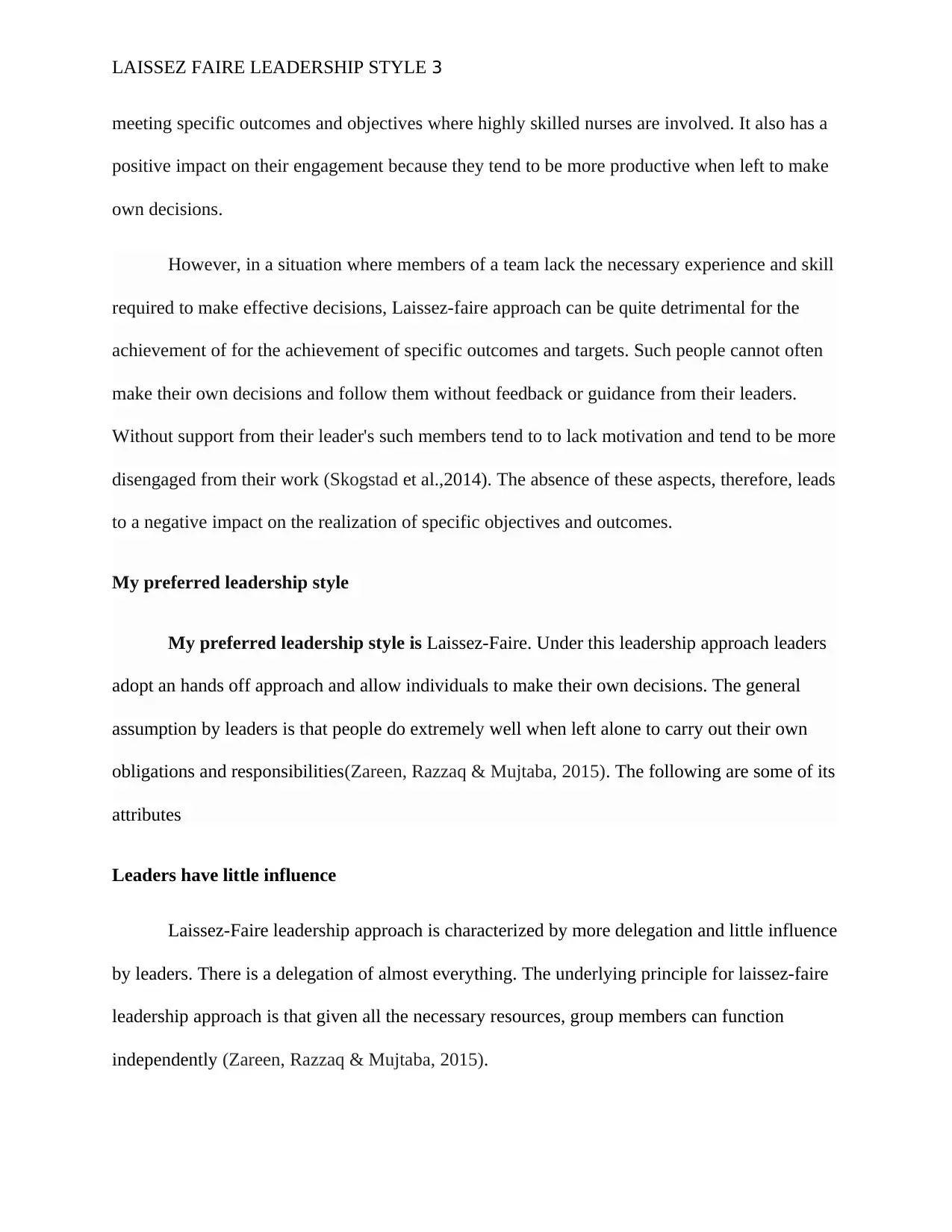
LAISSEZ FAIRE LEADERSHIP STYLE 3
meeting specific outcomes and objectives where highly skilled nurses are involved. It also has a
positive impact on their engagement because they tend to be more productive when left to make
own decisions.
However, in a situation where members of a team lack the necessary experience and skill
required to make effective decisions, Laissez-faire approach can be quite detrimental for the
achievement of for the achievement of specific outcomes and targets. Such people cannot often
make their own decisions and follow them without feedback or guidance from their leaders.
Without support from their leader's such members tend to to lack motivation and tend to be more
disengaged from their work (Skogstad et al.,2014). The absence of these aspects, therefore, leads
to a negative impact on the realization of specific objectives and outcomes.
My preferred leadership style
My preferred leadership style is Laissez-Faire. Under this leadership approach leaders
adopt an hands off approach and allow individuals to make their own decisions. The general
assumption by leaders is that people do extremely well when left alone to carry out their own
obligations and responsibilities(Zareen, Razzaq & Mujtaba, 2015). The following are some of its
attributes
Leaders have little influence
Laissez-Faire leadership approach is characterized by more delegation and little influence
by leaders. There is a delegation of almost everything. The underlying principle for laissez-faire
leadership approach is that given all the necessary resources, group members can function
independently (Zareen, Razzaq & Mujtaba, 2015).
meeting specific outcomes and objectives where highly skilled nurses are involved. It also has a
positive impact on their engagement because they tend to be more productive when left to make
own decisions.
However, in a situation where members of a team lack the necessary experience and skill
required to make effective decisions, Laissez-faire approach can be quite detrimental for the
achievement of for the achievement of specific outcomes and targets. Such people cannot often
make their own decisions and follow them without feedback or guidance from their leaders.
Without support from their leader's such members tend to to lack motivation and tend to be more
disengaged from their work (Skogstad et al.,2014). The absence of these aspects, therefore, leads
to a negative impact on the realization of specific objectives and outcomes.
My preferred leadership style
My preferred leadership style is Laissez-Faire. Under this leadership approach leaders
adopt an hands off approach and allow individuals to make their own decisions. The general
assumption by leaders is that people do extremely well when left alone to carry out their own
obligations and responsibilities(Zareen, Razzaq & Mujtaba, 2015). The following are some of its
attributes
Leaders have little influence
Laissez-Faire leadership approach is characterized by more delegation and little influence
by leaders. There is a delegation of almost everything. The underlying principle for laissez-faire
leadership approach is that given all the necessary resources, group members can function
independently (Zareen, Razzaq & Mujtaba, 2015).
⊘ This is a preview!⊘
Do you want full access?
Subscribe today to unlock all pages.

Trusted by 1+ million students worldwide
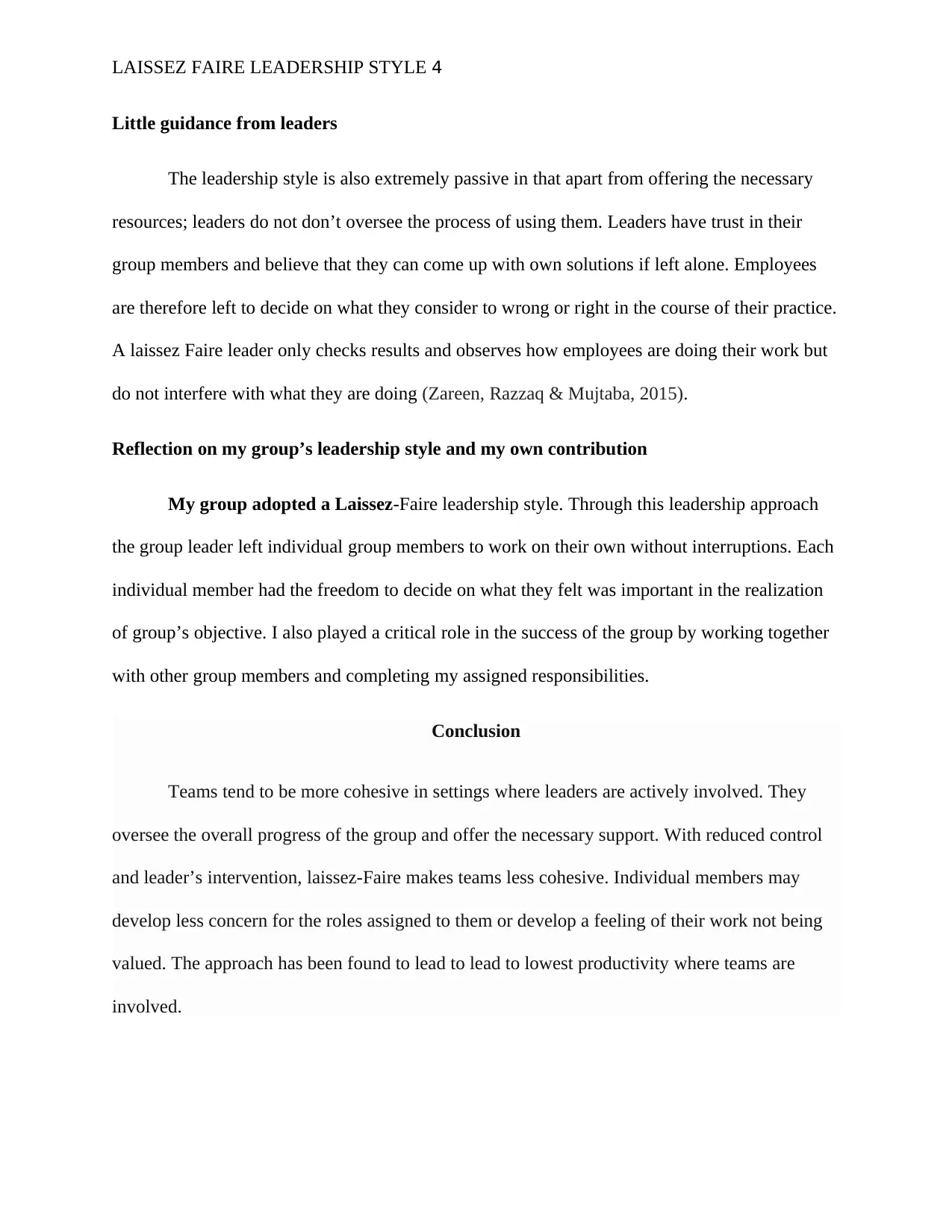
LAISSEZ FAIRE LEADERSHIP STYLE 4
Little guidance from leaders
The leadership style is also extremely passive in that apart from offering the necessary
resources; leaders do not don’t oversee the process of using them. Leaders have trust in their
group members and believe that they can come up with own solutions if left alone. Employees
are therefore left to decide on what they consider to wrong or right in the course of their practice.
A laissez Faire leader only checks results and observes how employees are doing their work but
do not interfere with what they are doing (Zareen, Razzaq & Mujtaba, 2015).
Reflection on my group’s leadership style and my own contribution
My group adopted a Laissez-Faire leadership style. Through this leadership approach
the group leader left individual group members to work on their own without interruptions. Each
individual member had the freedom to decide on what they felt was important in the realization
of group’s objective. I also played a critical role in the success of the group by working together
with other group members and completing my assigned responsibilities.
Conclusion
Teams tend to be more cohesive in settings where leaders are actively involved. They
oversee the overall progress of the group and offer the necessary support. With reduced control
and leader’s intervention, laissez-Faire makes teams less cohesive. Individual members may
develop less concern for the roles assigned to them or develop a feeling of their work not being
valued. The approach has been found to lead to lead to lowest productivity where teams are
involved.
Little guidance from leaders
The leadership style is also extremely passive in that apart from offering the necessary
resources; leaders do not don’t oversee the process of using them. Leaders have trust in their
group members and believe that they can come up with own solutions if left alone. Employees
are therefore left to decide on what they consider to wrong or right in the course of their practice.
A laissez Faire leader only checks results and observes how employees are doing their work but
do not interfere with what they are doing (Zareen, Razzaq & Mujtaba, 2015).
Reflection on my group’s leadership style and my own contribution
My group adopted a Laissez-Faire leadership style. Through this leadership approach
the group leader left individual group members to work on their own without interruptions. Each
individual member had the freedom to decide on what they felt was important in the realization
of group’s objective. I also played a critical role in the success of the group by working together
with other group members and completing my assigned responsibilities.
Conclusion
Teams tend to be more cohesive in settings where leaders are actively involved. They
oversee the overall progress of the group and offer the necessary support. With reduced control
and leader’s intervention, laissez-Faire makes teams less cohesive. Individual members may
develop less concern for the roles assigned to them or develop a feeling of their work not being
valued. The approach has been found to lead to lead to lowest productivity where teams are
involved.
Paraphrase This Document
Need a fresh take? Get an instant paraphrase of this document with our AI Paraphraser
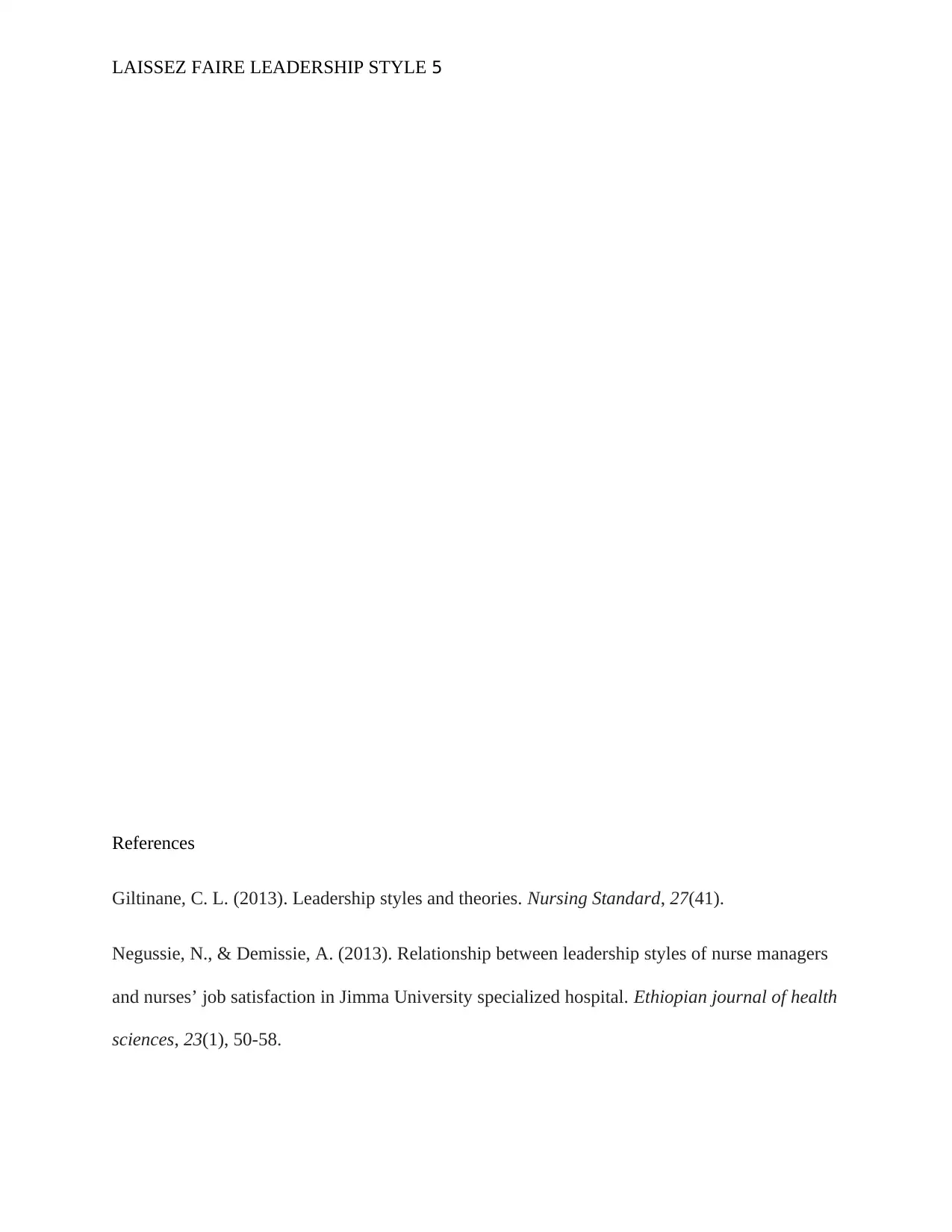
LAISSEZ FAIRE LEADERSHIP STYLE 5
References
Giltinane, C. L. (2013). Leadership styles and theories. Nursing Standard, 27(41).
Negussie, N., & Demissie, A. (2013). Relationship between leadership styles of nurse managers
and nurses’ job satisfaction in Jimma University specialized hospital. Ethiopian journal of health
sciences, 23(1), 50-58.
References
Giltinane, C. L. (2013). Leadership styles and theories. Nursing Standard, 27(41).
Negussie, N., & Demissie, A. (2013). Relationship between leadership styles of nurse managers
and nurses’ job satisfaction in Jimma University specialized hospital. Ethiopian journal of health
sciences, 23(1), 50-58.
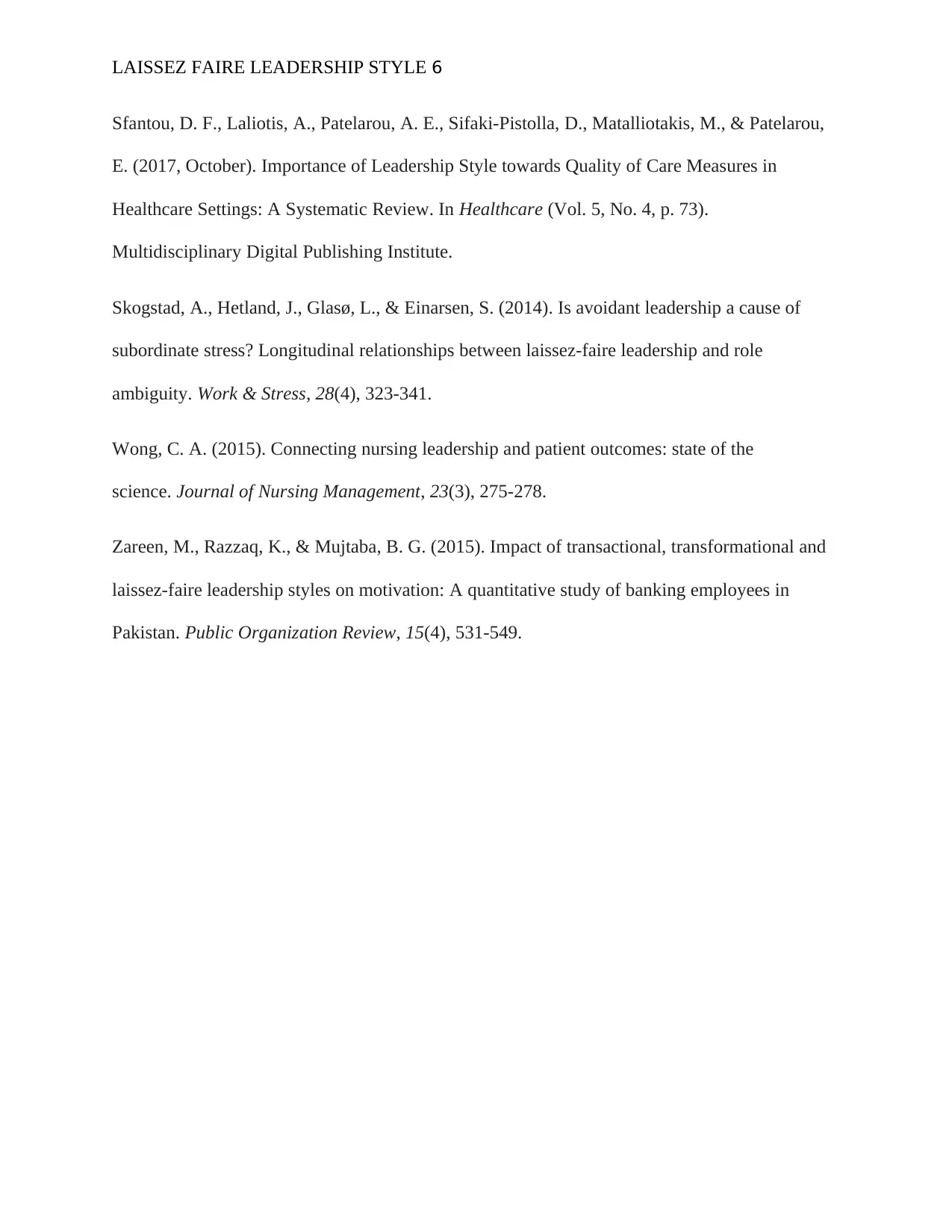
LAISSEZ FAIRE LEADERSHIP STYLE 6
Sfantou, D. F., Laliotis, A., Patelarou, A. E., Sifaki-Pistolla, D., Matalliotakis, M., & Patelarou,
E. (2017, October). Importance of Leadership Style towards Quality of Care Measures in
Healthcare Settings: A Systematic Review. In Healthcare (Vol. 5, No. 4, p. 73).
Multidisciplinary Digital Publishing Institute.
Skogstad, A., Hetland, J., Glasø, L., & Einarsen, S. (2014). Is avoidant leadership a cause of
subordinate stress? Longitudinal relationships between laissez-faire leadership and role
ambiguity. Work & Stress, 28(4), 323-341.
Wong, C. A. (2015). Connecting nursing leadership and patient outcomes: state of the
science. Journal of Nursing Management, 23(3), 275-278.
Zareen, M., Razzaq, K., & Mujtaba, B. G. (2015). Impact of transactional, transformational and
laissez-faire leadership styles on motivation: A quantitative study of banking employees in
Pakistan. Public Organization Review, 15(4), 531-549.
Sfantou, D. F., Laliotis, A., Patelarou, A. E., Sifaki-Pistolla, D., Matalliotakis, M., & Patelarou,
E. (2017, October). Importance of Leadership Style towards Quality of Care Measures in
Healthcare Settings: A Systematic Review. In Healthcare (Vol. 5, No. 4, p. 73).
Multidisciplinary Digital Publishing Institute.
Skogstad, A., Hetland, J., Glasø, L., & Einarsen, S. (2014). Is avoidant leadership a cause of
subordinate stress? Longitudinal relationships between laissez-faire leadership and role
ambiguity. Work & Stress, 28(4), 323-341.
Wong, C. A. (2015). Connecting nursing leadership and patient outcomes: state of the
science. Journal of Nursing Management, 23(3), 275-278.
Zareen, M., Razzaq, K., & Mujtaba, B. G. (2015). Impact of transactional, transformational and
laissez-faire leadership styles on motivation: A quantitative study of banking employees in
Pakistan. Public Organization Review, 15(4), 531-549.
⊘ This is a preview!⊘
Do you want full access?
Subscribe today to unlock all pages.

Trusted by 1+ million students worldwide

LAISSEZ FAIRE LEADERSHIP STYLE 7
1 out of 7
Related Documents
Your All-in-One AI-Powered Toolkit for Academic Success.
+13062052269
info@desklib.com
Available 24*7 on WhatsApp / Email
![[object Object]](/_next/static/media/star-bottom.7253800d.svg)
Unlock your academic potential
Copyright © 2020–2025 A2Z Services. All Rights Reserved. Developed and managed by ZUCOL.





